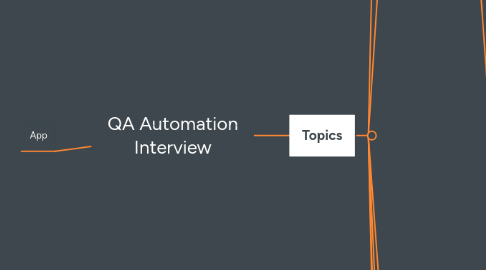
1. Topics
1.1. Scrum
1.1.1. What's Scrum?
1.1.1.1. It's a methodology to work in a team. Used to solve complex problems.
1.1.1.2. Effective collaboration
1.1.1.3. Agile is similar, but is more flexible and promotes leadership teams
1.1.2. What's Agile?
1.1.2.1. Agile scrum methodology is a project that depends on incremental development
1.1.2.2. Each iteration consists of two- to four-week sprints
1.1.2.3. Each sprint's goal is to build the most important features first and come out with a potentially deliverable product.
1.1.2.4. More features are built and adjusted based on customer feedback
1.1.2.5. Advantages
1.1.2.5.1. Products are built faster
1.1.2.5.2. Requires frequent planning and goal setting
1.1.2.5.3. Gets feedback faster from the client
1.1.3. Roles
1.1.3.1. Core Roles
1.1.3.1.1. Scrum master: Dev facilitator, leads daily meetings. Remove blockers
1.1.3.1.2. Product Owner: Represents stakeholders (customers). Knows business requirements and their details. Prioritize tasks
1.1.3.1.3. Scrum Team: Work group, developers, testers, automation engineers, designers
1.1.3.2. Ancillary Roles
1.1.3.2.1. Customers, Managers and Executives
1.1.3.2.2. Not involved in the development
1.1.3.2.3. Report progress and get feedback
1.1.4. Ceremonies
1.1.4.1. Sprint Planning: Define User Stories that the team will work on in the next Sprint.
1.1.4.2. Sprint Review: End of Sprint, team does a Demo of the new functionality in the project. Get Feedback
1.1.4.3. Sprint Retrospective: What went well, and not well during the sprint -> Define actions
1.1.4.4. Daily Scrum Meeting: 15min meeting. What's complete? what are you going to work today?, Any Blockers?
1.1.5. Artifacts
1.1.5.1. Product Backlog
1.1.5.2. Sprint Backlog
1.2. SQL
1.2.1. Basics
1.2.1.1. SELECT * FROM table_name;
1.2.1.2. SELECT DISTINCT column1, column2, ... return only distinct
1.2.1.3. WHERE condition1 AND condition2 OR condition3 AND NOT condition3 ...;
1.2.1.4. ORDER BY column1, column2, ... ASC|DESC;
1.2.1.5. Group By
1.2.1.5.1. SELECT COUNT(CustomerID), Country FROM Customers GROUP BY Country;
1.2.2. Medium
1.2.2.1. SELECT TOP number|percent column_name(s)
1.2.2.2. SELECT MIN | MAX (column_name)
1.2.2.3. SELECT COUNT(column_name) ...
1.2.2.4. SELECT AVG(column_name)
1.2.2.5. SELECT SUM(column_name)
1.2.2.6. ... WHERE columnN LIKE pattern;
1.2.2.6.1. WHERE CustomerName LIKE 'a%';
1.2.2.7. WHERE column_name IN (value1, value2, ...);
1.2.3. Actions
1.2.3.1. INSERT INTO table_name (column1, column2, column3, ...) VALUES (value1, value2, value3, ...);
1.2.3.2. UPDATE table_name SET column1 = value1, column2 = value2, ... WHERE condition;
1.2.3.3. DELETE FROM table_name WHERE condition;
1.2.4. Joins
1.2.4.1. Combine rows from two or more tables
1.2.4.2. Types
1.2.4.2.1. S
1.2.4.3. Inner
1.2.4.3.1. SELECT Orders.OrderID, Customers.CustomerName, Orders.OrderDate FROM Orders INNER JOIN Customers ON Orders.CustomerID=Customers.CustomerID;
1.2.4.4. Left
1.2.4.4.1. FROM table1 LEFT JOIN table2 ON table1.column_name = table2.column_name;
1.2.4.5. Right
1.2.4.5.1. FROM table1 RIGHT JOIN table2 ON table1.column_name = table2.column_name;
1.2.4.6. Outer
1.2.4.6.1. FULL OUTER JOIN table2 ON table1.column_name = table2.column_name WHERE condition;
1.2.4.7. Self Join
1.2.4.7.1. Table is joined with itself.
1.2.4.7.2. SELECT A.CustomerName AS CustomerName1, B.CustomerName AS CustomerName2, A.City FROM Customers A, Customers B WHERE A.CustomerID <> B.CustomerID AND A.City = B.City ORDER BY A.City;
1.3. API
1.3.1. Codigos de respuesta
1.3.1.1. S
1.3.1.2. 100
1.3.1.2.1. 100 Continue 101 Switching Protocols 102 Processing
1.3.1.3. 200
1.3.1.3.1. Client’s request was successfully received, understood, and accepted
1.3.1.3.2. 200 OK 201 Created 204 No Content 202 - Accepted 203 - Non-authoritative Information 205 - Reset Content
1.3.1.4. 300
1.3.1.4.1. Redirection: Further action needs to be taken by the client in order to fulfill the request
1.3.1.4.2. 301 Moved Permanently 302 Found - Temporarily under different URI 304 Not Modified 305 Use Proxy
1.3.1.5. 400
1.3.1.5.1. 4×× Client Error
1.3.1.5.2. 400 Bad Request 401 Unauthorized 403 Forbidden 404 Not Found
1.3.1.6. 500
1.3.1.6.1. 5×× Server Error
1.3.1.6.2. 500 Internal Server Error 502 Bad Gateway 503 Service Unavailable 504 Gateway Timeout
1.3.2. API
1.3.2.1. GET & POST (has Body)
1.3.2.1.1. Include Headers
1.3.2.2. Paramters: Double curly brackets: {{sample}}
1.3.2.3. Methods
1.3.2.3.1. GET POST PUT (Replace) PATCH(Update) DELETE
1.3.3. Postman
1.3.3.1. Advantages
1.3.3.1.1. Accessibility
1.3.3.1.2. Collections
1.3.3.1.3. Collaboration
1.3.3.1.4. Environments | Parameters
1.3.3.1.5. Creation of Tests
1.3.3.1.6. Automation Testing - Newman
1.3.3.1.7. Debugging
1.3.3.1.8. Continuous Integration
1.3.3.2. Creation of Tests
1.3.3.2.1. Javascript code, compare expected responses codes
1.3.3.2.2. Can use Environments and Parameters
1.3.3.2.3. pm.test("Status is Success", function(){ pm.response.to.have.status(200); } )
1.4. Testing
1.4.1. Basics
1.4.1.1. Test Case: Step by step on how to perform a test
1.4.1.2. Test Plan: Testing Plan Covers testing Scope, Approach, Resources and Schedule
1.4.1.3. Test Scenario: Describe a functionality that can be tested
1.4.1.4. Test Strategy: High-level
1.4.2. Requirements Traceability Matrix (RTM)
1.4.2.1. Make sure all requieremets are covered
1.4.2.2. Matrix Requiremet Vs Test Cases, set if TC cover all of them
1.4.3. Verify Vs Validation
1.4.3.1. Verification: Are we building the system properly?
1.4.3.1.1. System has all requirements
1.4.3.2. Validation: Are we building the proper system?
1.4.3.2.1. Satisfies needs and expectaions
1.5. Selenium
1.5.1. Type of Waits
1.5.1.1. Implicit Wait - Wait for a certain amount of time
1.5.1.2. Explicit Wait - Wait for specific conditions (Expected Conditions) or maximum time exceeded
1.5.2. Assert Vs Verify
1.5.2.1. Assert: If FALSE, execution is stopped
1.5.2.1.1. Assert.assertEquals
1.5.2.2. Verify: Execution continues
1.5.2.2.1. softAssert.assertEquals()
1.5.3. Quizz
1.5.4. Selenium + Java Cheat Sheet
1.6. Java
1.6.1. Variables
1.6.2. Classes, Interfaces
1.6.3. Compiler
